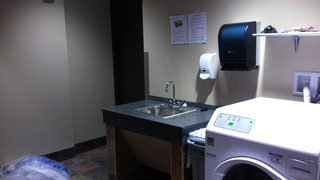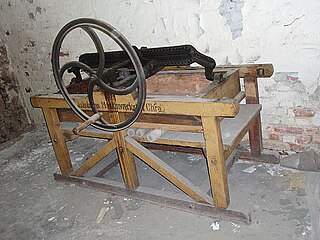
A laundry symbol, also called a care symbol, is a pictogram which represents a method of washing, for example drying, dry-cleaning and ironing clothing. Such symbols are written on labels, known as care labels or care tags, attached to clothing to indicate how a particular item should best be cleaned. Standard symbols for these care labels differ by region. In some standards, pictograms coexist with or are complemented by written instructions.

Extreme ironing is an extreme sport in which people take ironing boards to remote locations and iron items of clothing. According to the Extreme Ironing Bureau, extreme ironing is "the latest danger sport that combines the thrills of an extreme outdoor activity with the satisfaction of a well-pressed shirt."
The 1st Extreme Ironing World Championships was the inaugural championship for the quirky British sport of extreme ironing.
A dangling modifier or misplaced modifier is a type of ambiguous grammatical construct whereby a grammatical modifier could be misinterpreted as being associated with a word other than the one intended, or with no particular word at all. For example, a writer may have meant to modify the subject, but word order used means that the modifier appears to modify an object instead. Such ambiguities can lead to unintentional humor, or, in formal contexts, difficulty in comprehension.

A clothes iron is a small appliance that, when heated, is used to press clothes to remove creases and help prevent the spread of infectious disease. Domestic irons generally range in operating temperature from between 250 °F (121 °C) to 360 °F (182 °C). It is named for the metal (iron) of which the device was historically made, and the use of it is generally called ironing. Ironing works by loosening the ties between the long chains of molecules that exist in polymer fiber materials. With the heat and the weight of the ironing plate, the fibers are stretched and the fabric maintains its new shape when cool. Some materials, such as cotton, require the use of water to loosen the intermolecular bonds.

A laundry room is a room where clothes are washed and dried. In a modern home, a laundry room would be equipped with an automatic washing machine and clothes dryer, and often a large basin, called a laundry tub, for hand-washing delicate articles of clothing such as sweaters, and an ironing board. A typical laundry room is located in the basement of older homes, but in many modern homes, the laundry room might be found on the main floor near the kitchen or upstairs near the bedrooms.

The box mangle is said to have been invented in the 17th century. It consisted of a heavy frame containing a large box filled with rocks, resting on a series of long wooden rollers. Damp laundry could be laid flat under rollers, or wound round the rollers: sometimes enclosed in a sheet in order to keep the laundry clean. When the rollers were filled, one or two people pulled on levers or turned cranks to move the heavy box back and forth over the rollers. The mangle's primary purpose was to press household linen and clothing smooth.
Sta-Prest is a brand of wrinkle-resistant trousers produced by Levi Strauss & Co., beginning in 1964.
Suite Novotel is a chain of 3-star hotels owned by the Accor Group, it is a relatively new fast-growing chain targeting families and businessmen. The rooms cost upwards of €100.
Breast ironing, also known as breast flattening, is the pounding and massaging of a pubescent girl's breasts, using hard or heated objects, to try to make them stop developing or disappear. The practice is typically performed by a close female figure to the victim, traditionally fulfilled by a mother, grandmother, aunt, or female guardian who will say she is trying to protect the girl from sexual harassment and rape, to prevent early pregnancy that would tarnish the family name, preventing the spread of sexually transmitted infections such as HIV/AIDs, or to allow the girl to pursue education rather than be forced into early marriage. It is mostly practiced in parts of Cameroon, where boys and men may think that girls whose breasts have begun to grow are ready for sex. Evidence suggests that it has spread to the Cameroonian diaspora, for example to Britain, where the law defines it as child abuse. The most widely used implement for breast ironing is a wooden pestle normally used for pounding tubers. Other tools used include leaves, bananas, coconut shells, grinding stones, ladles, spatulas, and hammers heated over coals. The ironing practice is generally performed around dusk or dawn in a private area such as the household kitchen to prevent others from seeing the victim or becoming aware of the process, particularly fathers or other male figures. The massaging process could occur anywhere between one week to several months, depending on the victim's refusal and the resistance of the breasts; in cases where the breasts appear to be consistently protruding, the ironing practice may occur more than once a day for these weeks or months at a time.
Ironing is a sheet metal forming process that uniformly thins the workpiece in a specific area.

Cold ironing, or shore connection, shore-to-ship power (SSP) or alternative maritime power (AMP), is the process of providing shoreside electrical power to a ship at berth while its main and auxiliary engines are turned off. Cold ironing permits emergency equipment, refrigeration, cooling, heating, lighting and other equipment to receive continuous electrical power while the ship loads or unloads its cargo. Shorepower is a general term to describe supply of electric power to ships, small craft, aircraft and road vehicles while stationary.

Ironing is the use of a machine, usually a heated tool, to remove wrinkles from fabric. The heating is commonly done to a temperature of 180–220 °Celsius, depending on the fabric. Ironing works by loosening the bonds between the long-chain polymer molecules in the fibers of the material. While the molecules are hot, the fibers are straightened by the weight of the iron, and they hold their new shape as they cool. Some fabrics, such as cotton, require the addition of water to loosen the intermolecular bonds. Many modern fabrics are advertised as needing little or no ironing. Permanent press clothing was developed to reduce the ironing necessary by combining wrinkle-resistant polyester with cotton.
Be Up to Date was the title for a 1938 Betty Boop animated short film.
Sarah Boone (1832–1904) was an African American inventor who on April 26, 1892, obtained United States patent rights for her improvements to the ironing board. Boone's ironing board was designed to improve the quality of ironing sleeves and the bodies of women's garments. The board was very narrow, curved, and made of wood. The shape and structure allowed it to fit a sleeve and it was reversible, so one could iron both sides of the sleeve. Along with Miriam Benjamin, Ellen Eglin, and Sarah Goode, Boone was one of four African American women inventors of her time who developed new technology for the home.
Samuel Moore, who performs and records as Ironing Board Sam, is an American electric blues keyboardist, singer and songwriter, who has released a small number of singles and albums. His musical career, despite several low points, has spanned over fifty years, and he released a new album in 2012. "I'll tell you one thing, it's the blues," he stated. "That's why I look like a blues man now."

Minky is the trading name of Vale Mill (Rochdale) Limited, a company based in Rochdale, Greater Manchester, United Kingdom that produces cleaning material and equipment.
Woman Ironing (1904) is an oil painting by Pablo Picasso completed during the artist's Blue Period (1901—1904). This evocative image, painted in neutral tones of blue and gray, depicts an emaciated woman with hollowed eyes, sunken cheeks, and bent form, as she presses down on an iron with all her will. A recurrent subject matter for Picasso during this time is the desolation of social outsiders. This painting, as the rest of his works of the Blue Period, is inspired by his life in Spain but was painted in Paris.

Countess Ironing-Maid is a 1926 German silent comedy film directed by Constantin J. David and starring Ossi Oswalda, Curt Bois and Robert Garrison.
"Rainin' in My Heart" is a song written by James Moore and Jerry West and performed by Harpo. It reached number 17 on the U.S. R&B chart and number 34 on the U.S. pop chart in 1961. It was featured on his 1961 album Slim Harpo Sings "Raining in My Heart..."








